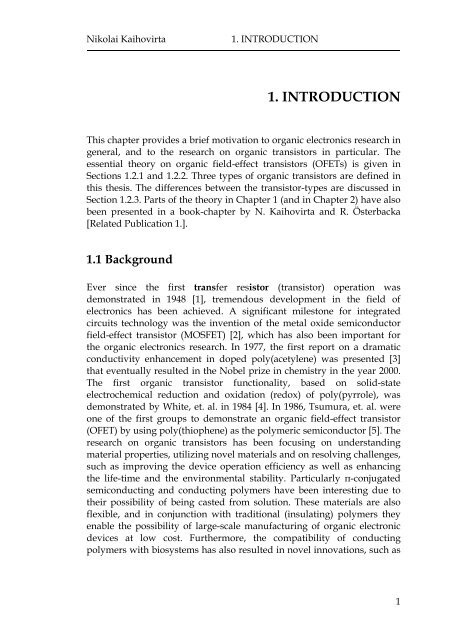ION MODULATED ORGANIC TRANSISTORS - Doria
ION MODULATED ORGANIC TRANSISTORS - Doria
ION MODULATED ORGANIC TRANSISTORS - Doria
- No tags were found...
You also want an ePaper? Increase the reach of your titles
YUMPU automatically turns print PDFs into web optimized ePapers that Google loves.
Nikolai Kaihovirta1. INTRODUCT<strong>ION</strong>1. INTRODUCT<strong>ION</strong>This chapter provides a brief motivation to organic electronics research ingeneral, and to the research on organic transistors in particular. Theessential theory on organic field-effect transistors (OFETs) is given inSections 1.2.1 and 1.2.2. Three types of organic transistors are defined inthis thesis. The differences between the transistor-types are discussed inSection 1.2.3. Parts of the theory in Chapter 1 (and in Chapter 2) have alsobeen presented in a book-chapter by N. Kaihovirta and R. Österbacka[Related Publication 1.].1.1 BackgroundEver since the first transfer resistor (transistor) operation wasdemonstrated in 1948 [1], tremendous development in the field ofelectronics has been achieved. A significant milestone for integratedcircuits technology was the invention of the metal oxide semiconductorfield-effect transistor (MOSFET) [2], which has also been important forthe organic electronics research. In 1977, the first report on a dramaticconductivity enhancement in doped poly(acetylene) was presented [3]that eventually resulted in the Nobel prize in chemistry in the year 2000.The first organic transistor functionality, based on solid-stateelectrochemical reduction and oxidation (redox) of poly(pyrrole), wasdemonstrated by White, et. al. in 1984 [4]. In 1986, Tsumura, et. al. wereone of the first groups to demonstrate an organic field-effect transistor(OFET) by using poly(thiophene) as the polymeric semiconductor [5]. Theresearch on organic transistors has been focusing on understandingmaterial properties, utilizing novel materials and on resolving challenges,such as improving the device operation efficiency as well as enhancingthe life-time and the environmental stability. Particularly π-conjugatedsemiconducting and conducting polymers have been interesting due totheir possibility of being casted from solution. These materials are alsoflexible, and in conjunction with traditional (insulating) polymers theyenable the possibility of large-scale manufacturing of organic electronicdevices at low cost. Furthermore, the compatibility of conductingpolymers with biosystems has also resulted in novel innovations, such as1
















